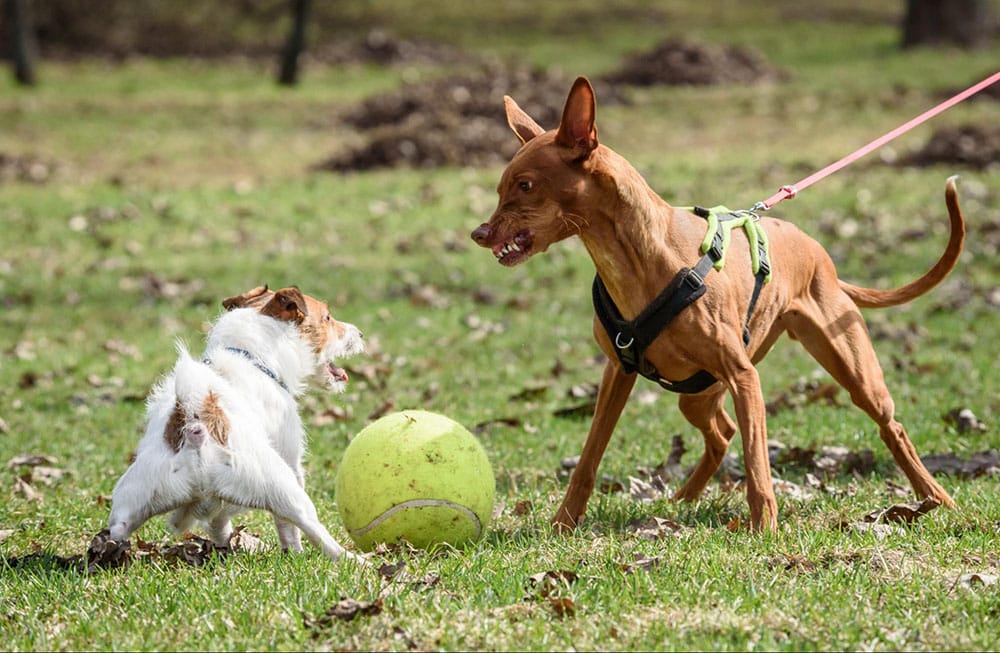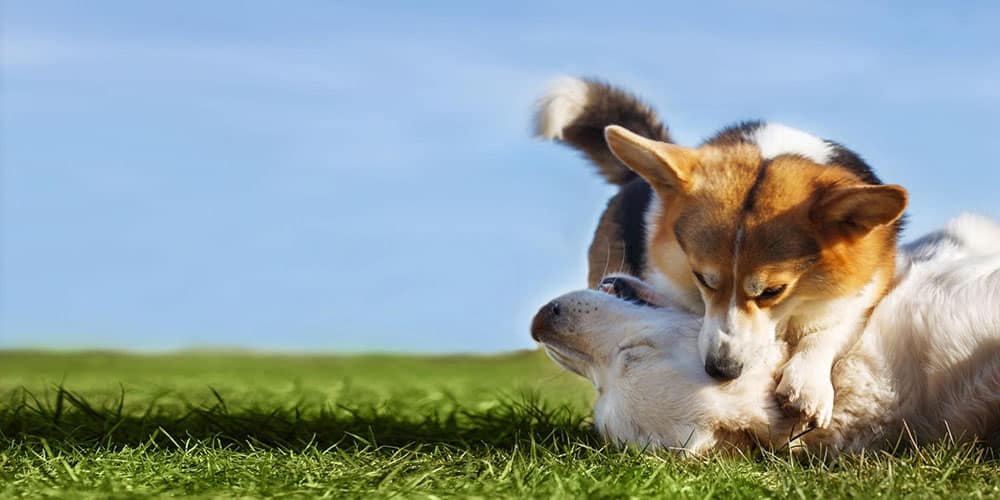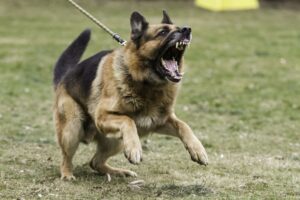I am a Cesar fan and have a question regarding dogs at ‘play.’ My first obvious thought is that if your dogs have the energy to play, they need more exercise, correct?’ In any event, what types of play do you allow in your pack?
I have a very playful two-year-old, high-energy Doberman named Klohee.’ She gets along well with other dogs: play bows, lays down to bait them to play, etc., but is quite obnoxious at times about playing, i.e., does not know when to stop.’ Even after exercise, she always has enough energy to play with other dogs.’ Listed below are some of my observations of her play.’ Can you tell me which behaviors should be allowed and to what extent I should ‘break it up’ as her pack leader?’ How can I tell if the play is reciprocal or if she’s just being pushy?
Observations:
- Play bows
- She lays down to reassure that she means no harm
- She loves to run and play chase with other dogs (Her favorite thing)
- Occasionally barks if they don’t bite the bait to play (Is she demanding?)
- Bites on the back of the neck (Intensity varies on another dog)
- Nips at legs
- Plays the bite-each-other’s mouth game?
- Licks other dogs’ faces
- She sometimes gives the other dogs her toys/chewies (A bribe, perhaps?)
Thanks in advance!’ I could use your advice on this one.’ I know the basics on dog body language but need clarification on the whole play thing.’ It looks like they both enjoy it, but they play rough to the human eye!
Bryan Bone
Cesar Responds
Dear Bryan,
The following are my reactions to your observations of Klohee, who sounds like a very playful Doberman indeed!
- Play bows. That’s great!
- She lies down to reassure she means no harm. – Perfect!
- Run, chase, and play with other dogs. That’s what dogs do!
- Barks if they don’t take the bait to play. – There’s nothing wrong with that.
- Bites back of the neck. – If they’re part of her pack, it’s okay, but I would discourage this behavior if they’re not dogs she recognizes as regular friends and family.’
- Nips at legs. – This is more irritating to a dog than a bite to the neck. Dogs do this when the other dog is not paying attention.’ If the dog she is nipping is not a dog you trust, do not allow the nipping on the leg.’ This could lead to a conflict or fight.
- Plays the ‘bite-each-other’s mouth’ game.- This is normal play behavior.
- Licks other dogs’ faces. – This is an acceptable play activity with other pack members – unless it becomes obsessive. There are three levels of intensity: mild, medium, and high.’ I do not allow activities to reach a high intensity unless I create the game. For example, if I play ball with them, I let them go to the highest energy level. However, if they do it among themselves, I only allow them to reach a mild or medium intensity.’ The same behavior at a different energy level can create a fight simply because it was a high-level energy moment.
- Gives other dogs her toys/chewies. – This indicates that she would be in the middle of a pack of dogs.’ She’d be the one who would keep the dogs in the back and the dogs in front as a unit.
You mentioned that your dog has enough energy to play after she does exercise or goes for a walk. Absolutely! Utilizing extra energy in play is an excellent way for dogs to celebrate the day. All dogs at the Dog Psychology Center play after exercise and don’t play for an extended period. After feeding times and when the temperature cools at around 5 pm, everybody here is frisky and playful, but playtime only lasts about fifteen minutes. After that, they are tired!
Based on your information, Klohee is a high-energy, submissive dog.’ The goal is to make her calm-submissive.’ You’ve got one-half of the battle accomplished already!’ Walking her with a backpack is a great way to drain energy and move toward accomplishing that second half!
Stay calm and assertive,
Cesar Millan
Why Is Play Important for Dogs?
Play is a crucial part of a dog’s day as it allows them to get exercise, reduce stress, and release much-needed energy. When our pets play, they gain social and motor skills that are key for any pack member. Teaching our pups good play behavior aids in brain development and how to appropriately interact with other dogs.
Starting while your puppy is young is critical, and playing with other dogs will help teach your pup appropriate play. Dogs learn by doing and by mimicking. So, while doggie play dates can be fun, use the opportunity to teach your furry friend what is expected during playtime. These interactions with your puppy will lead them to connect socially, bond, and communicate.
What Does Good Play Look Like
It can sometimes be difficult for people to determine what good play behavior looks like. However, if you observe the dog’s body language, you can figure out if both pups are enjoying the playtime. When both pets consent to play, you will watch for relaxed body posture and return for more fun.
Signs That Dogs Are Playing
- Acting silly, excessive bouncy movement
- Open-mouthed grin
- The dog continues to go back for more play. Even the one who ends up on their back
- The front end down and back end in the air is a play bow
- Repeatedly slapping front paws on the ground to initiate play
- Pretends to fall over and expose the belly
- Allows being “caught” during a game of chase, taking turns chasing each other

What Does Bad Dog Play Look Like
Certain breeds of dogs are wired to be “pushy,” while others may not be socially trained to interact well. Sometimes what started as a fun playdate can quickly become aggressive, and recognizing when aggression has set in is essential for the safety of all involved.
Signs That Dogs Are Fighting
- A warning growl accompanied by a curled lip and closed mouth
- If an actual fight, the loser will not return for more “play.”
- Ears are pinned back, and no big smiles.
- No bouncy, fun movement. The dog will move around quickly
- The hair will be standing up (hackles), which might not be noticeable if your dog has long hair
- The body will be stiff, and body language is not happy
- Tail is tucked
- One of the dogs is trying to get away from the other one
- It’s clear that the dogs are not having fun
How To Spot a Potential Aggressive Dog
As a pack leader, you need to be aware of your dog’s body language and identify factors that give you the inclination that they might become aggressive. Suppose you encounter another dog who becomes aggressive with your pup. In that case, you may need to help your furry friend recognize the unsafe behavior and remove them from the situation quickly and calmly. Below are signs to watch out for in an aggressive pup.
- A tense stare and squared-off stance.
- A posture that looks like the dog is guarding. The neck is lower than the shoulders, and the head is lowered and stretched forward.
- A straight and stiff tail.
- The nose is upturned, exposing the teeth.
- Hair is standing up.
- Ears are standing straight up or flat back.
How To Detect Early Signs of Aggression
As a pack leader, it is essential to recognize early warning signs of aggression in your dog. Doing so will protect your pup, other dogs, and humans. Sometimes puppies that are nervous or anxious may show signs of early aggression. It’s best to seek professional help to get the issue resolved. Here are some behaviors to look out for:
- Rough play is too much for one of the dogs. If your dog continues to play roughly when the other playmate is done, it could lead to aggressive behavior. Be mindful of one pup enjoying the “playtime” more than the other.
- Continuing to chase or bother. If one of the dogs has given signals that they are done playing, but your dog does not stop but instead continues to pester the other dog, their behavior could become aggressive and take a wrong turn.
- Dogs can be bullies too. As with humans, dogs who bully often lack appropriate social skills and confidence. As their pack leader, you teach and train your pup on how to behave. Bullying could look like body slamming, inappropriate biting, and not stopping when the other dog clearly shows they are done.
Commonly Asked Questions About Dog Behavior
Are All Dogs Suited For the Dog Park?
Although some pets do well and interact nicely with other dogs at the dog park, some dogs respond better to playing at home or with another dog buddy they already have a relationship with. Something to note is the gated dog park is a wonderful and neutral location to introduce potential puppy pals rather than at your home. Be sure to supervise the initial interaction and watch the playtime closely.
What Should I Do if My Dog Gets Into a Fight?
Unfortunately, there may come a time when your pet gets into a fight with another dog. Knowing how to handle yourself and your dog in this situation is essential to keeping everyone safe. Do not attempt to separate the dogs by grabbing their collar or any part of their body. A loud noise might be enough to stop the fight, and an air horn is a great tool to keep in your car. If you are at home, using a hose and spraying water on both dogs’ heads can break them up.
How Do I Keep My Dog From Getting Aggressive?
The best way to prevent your pet from getting into a fight with another dog is to recognize signs of aggression and promptly remove and separate the animals before the situation worsens.
How Do I Know If Another Dog Is Ready to Play?
If you are still determining if the pup your dog wants to engage with is ready to play, do a quick separation test. Once they are separated, if they both run back to play again, that’s a sign that both consent to the play session. If one of the dogs runs away from the situation, stop the playdate and move on.











